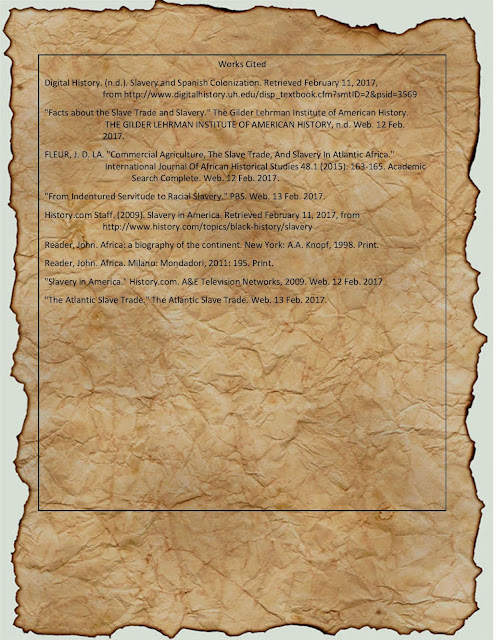https://www.google.com/maps/d/edit?mid=1uYgg-9VfpRdBUnvHfI-YPncqwVI&ll=28.568012018388195%2C-48.81151279680353&z=3
Explanatory Paragraph:
The Transatlantic Slave Trade, through which millions of people from the African continent were sold into slavery and transported across the Atlantic Ocean, is inextricably linked to the Colombian Exchange, which saw the trading of various crops types from the “Old World” to the “New World” and vice versa. The major cash crops from the trade include sugar (both sugar cane and refined sugar), tobacco, chocolate, and cotton. The ease with which these crops were grown resulted in a rapid expansion of the local populations as well as in the volume of the commodities demanded. Consequently, this expansion called for more agricultural production and ultimately more slaves. “The slave trade increased in the seventeenth century, as more large-scale agricultural production increased the need for labor” (Rose). With the increased need for labor, slave traders had to go ever deeper into the continent, due to the fact that the populations of viable slaves in Western Africa had been sucked dry. Therefore, we can conclude that the crops that moved back and forth between the New and Old Worlds were the ones that were easily cultivated and profited from, and that the Slave Trade was ultimately the tool used to provide the workforce needed for their cultivation.
Works Cited:
Alvarez, Jose. "Cuban Agriculture Before 1959: The Political and Economic Situations." EDIS New
Publications RSS. Food and Resource Economics, 29 Apr. 2016. Web. 23 Feb. 2017.
Corbett, Bob. "Short and Oversimplified History of Haiti." Short and Oversimplified History of Haiti.
Webster University, Aug. 1999. Web. 23 Feb. 2017.
Johnston, Mark. "The Sugar Trade in the West Indies and Brazil Between 1492 and 1700."The
Sugar Trade in the West Indies and Brazil Between 1492 and 1700. University of
Minnesota Libraries, n.d. Web. 23 Feb. 2017
Klein, Christopher. "The Sweet History of Chocolate." History.com. A&E Television Networks, 13
Feb. 2014. Web. 23 Feb. 2017.
Lokken, Paul. "Sugar Plantations and African Origins in Colonial Guatemala, 1650-1720." Latin
American Studies Association Meeting. Texas, Dallas. 23 Mar. 2003. Reading
"The Middle Passage." Abolition.e2bn.org. N.p., n.d. Web. 23 Feb. 2017.
Randall, Vernellia R. "The History of Tobacco." The History of Tobacco. N.p., 31 Jan. 1998. Web. 23 Feb. 2017.
Roberts, R.C. "Soil Survey of Puerto Rico." University of Florida Digital Collections. United States
Department of Agriculture, n.d. Web. 23 Feb. 2017.
Rose, Christopher. “Episode 6: Effects of the Atlantic Slave Trade on the Americas.” “15 Minute History.” The University of Texas at Austin. 3 Dec. 2012. Web. 17 Feb. 2017. 3 Dec.
"Slavery in the Americas." Slavery and Remembrance. United Nations Educational, Scientific, and
Cultural Organization, n.d. Web. 23 Feb. 2017.



